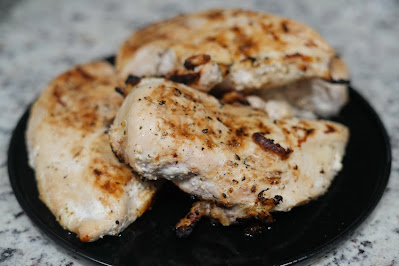The Greek continues. I mentioned in my last post featuring Greek Potato Salad that I did some Greek cooking recently. When making gyros, though, I had to make a decision: lamb or chicken?
Gyros are well-established with Greek food. A pita filled with slow-roasted, thinly sliced meet, raw red onion, tomato, tzatziki, and lettuce, these are the staples of Greek fast food. Locally, my favorite places to get them are at the Greek churches during Greek fest (where I also stock up on desserts) and a really great place nearby named Papa Sabz (10/10, would recommend).
If you've read much of this blog, you'll already know that I'm trying to edge out of chicken breasts as the standard for chicken. After all, chicken thighs have much more flavor for many dishes (and would have been totally appropriate here). With that in mind, one might assume I'd gravitate towards lamb. And while true for buying a gyro at a restaurant, I picked chicken for home, and for good reason.
When I went to Greece last year, I visited Athens, Mykonos, and Artemida. Walking is my favorite way to explore cities while visiting, and I discovered pretty quickly that the gyros of Greece are not equal to the gyros of America. Before we dig deeper there, how old is the gyro?
Established in the 1920s from a blend of cultures (as many excellent foods are, we seem to keep learning), the gyro came about largely with Armenian influence, according to one chef. Many had relocated to Greece from Istanbul and Ismir (then Constantinople and Smyrna). Many Mediterranean foods are similar, as I go to a Turkish restaurant locally to get some of my favorite foods, such as a lamb roll up that reminds me much of a gyro. So, though associated with Greece, the gyro is not really owned by any one place.
Returning to my trip (and oh how I long to return!), as I walked many miles through the cities, I noticed that lamb was not the main feature of souvlaki and gyros in Greece. It was pork first, chicken second, and occasionally I'd see lamb (which I can only presume is for the tourists). Here's an article on the topic, as well. So in America, we have stuck to the idea of lamb, but in Greece: it's pork.
So when it came to my cooking at home, I wanted to be more authentic. I don't eat pork, so chicken was the choice. And I was going to make it good chicken. I marinated it first in a Greek yogurt and herb mixture for about 4 hours (though I'd say no less than 2, ideally).
After that, we grilled the chicken, but they can also be cooked in a griddle pan for 7-10 minutes per side. We wound up with pretty thick chicken breasts so these took a little longer. Best way to tell is making sure it is cooked to 165 degrees F.
Last but certainly not least, I sliced the chicken thin and laid out some warmed pita and toppings. Tzatziki is also easy to make, though my blog post on it is severely outdated. You blend an English cucumber (you can use a regular one but English is standard), strain out the excess liquid, and mix in Greek yogurt, lemon juice, garlic, dill, salt and pepper.
And just like that, "Master, dinner is prepared!" (read that like Magenta from Rocky Horror, please).
Chicken Gyros Recipe
Ingredients:
4 chicken breasts (about 2 pounds, thighs can be used as well)
1/2 cup Greek yogurt
Ingredients:
4 chicken breasts (about 2 pounds, thighs can be used as well)
1/2 cup Greek yogurt
3 teaspoons minced garlic (about garlic cloves)
1 tablespoon white wine vinegar
3 tablespoons lemon juice
1 tablespoon extra virgin olive oil
1 teaspoon dried oregano
1 teaspoon salt
1/2 teaspoon pepper
Pitas
Toppings:
Tzatziki sauce
Red onion
Tomatoes
Instructions:
In a small bowl, mix yogurt, garlic, vinegar, lemon juice, olive oil, oregano, salt, and pepper. Spread on chicken, place in a bowl, and refrigerate for at least 2 hours. Grill for about 30 minutes on medium heat, or cook in a griddle pan on the stove for 7-10 minutes per side (depending on thickness). Slice chicken thin, then serve on pita with toppings.
adapted from greek chicken gyros






No comments:
Post a Comment